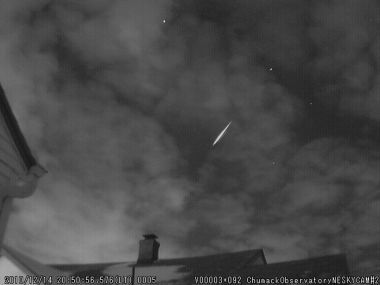Falling Meteor
 A meteor of initial mass
m
0
enters the earths atmosphere and starts falling from rest under the influence of gravity. Assume that the meteor gains mass from the cloud at a rate proportional to the momentum of the meteor,
d
t
d
m
0
=
k
m
0
v
, where
v
instantaneous velocity of the meteor. If
k
is equal to
5
m
−
1
, what will be the terminal velocity of the meteor?
A meteor of initial mass
m
0
enters the earths atmosphere and starts falling from rest under the influence of gravity. Assume that the meteor gains mass from the cloud at a rate proportional to the momentum of the meteor,
d
t
d
m
0
=
k
m
0
v
, where
v
instantaneous velocity of the meteor. If
k
is equal to
5
m
−
1
, what will be the terminal velocity of the meteor?
Take into consideration the buoyant force of the cloud
Details and assumption
You may neglect air resistance.
Take gravitational acceleration 9 . 8 m / s 2
The answer is 1.4.
This section requires Javascript.
You are seeing this because something didn't load right. We suggest you, (a) try
refreshing the page, (b) enabling javascript if it is disabled on your browser and,
finally, (c)
loading the
non-javascript version of this page
. We're sorry about the hassle.
1 solution
You don't consider buoyant force!
Log in to reply
When I wrote this solution, it was not mentioned in the question to take buoyant force into consideration. But there is no density given, so how do I consider it?
Log in to reply
Well, I considered it like this(assuming the meteor was initially small) :
m − m 0 = ρ V
⇒ , F b = ( m − m 0 ) g
⇒ F n e t = m g − F b = m 0 g , which turns out to be constant. If you differentiate m 0 g = v d t d m = k m v 2 and put d t d v = 0 you get v s t e a d y = 0 .
Log in to reply
@Jatin Yadav – @jatin yadav correct me if i am wrong but i think the solution is correct if we take buoyant force into consideration. We know that in a cloud buoyant force and gravitational force are balanced. Lets take the mass of the cloud gained by the rock to be m c .During time of falling there is an external gravitational force acting on the system and a buoyant force in the cloud that is keeping the mass element m c from falling. Since the total force on the mass element m c is zero, the total external force acting on the system is just the gravitational force acting on the meteor. Even though the solution doesn't show that
Log in to reply
@Beakal Tiliksew – That was what I was saying. The gravitational and buoyant force on m c is balanced. Hence, the net force on system is the gravitational force on m 0 that is m 0 g . This was what I got. You will apply newton's law on system. Hence, my equations are correct!
Log in to reply
@Jatin Yadav – I have made a modification of the problem to clear things up.
m 0 g = m 0 d t d v + v d t d m 0 → d t d m 0 = k m 0 v ,
d t d v = 0 , ⟹ g = k v 2
My apologies for any confusion that i may have caused, thanks for the follow up
@Beakal Tiliksew – why both force is balancing??????
Log in to reply
@Naman Negi – A cloud stays aflot because the the buoyant force balance gravitational force
ps taking buoyant force into consideration was stated from the beginning;)
Good one!
I probably should have done that>
Did the exact same way, but wrote lesser steps. Just two lines. Yeah non constant g varying with height would have been a good problem. I directly used the formula F= Fext+ vrel(dm/dt), well using basic ideas is also good, as always I try less to mug up equations in physics but at the end some I forget the original derivation but the formula is still there. Good refresher.
Exactly what I did.
A good problem, but I think it would have been better if g wasn't assumed to be constant.
Writing Newton's 2nd Law,
F = d t d p
m g = d t d ( m v ) = d t d m v + d t d v m
Now,
It is given that,
d t d m = k m v
Substituting this value back in the equation,
m g = k m v 2 + m d t d v
g = k v 2 + d t d v
Note that, when the terminal velocity is achieved, the value of the velocity will not change further (it is obvious why). In other words,
d t d v = 0
Hence,
g = k v 2
v t e r m = k g = 1 . 4 m / s